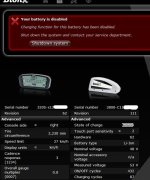marty said:
To enter the access section you push on MODE and CHRONO in same time.
2001: KM or Miles
2002: Generative Breaking
2003: Time last with the battery
2004: Clock
2005: Wheel size
2006: Programming brake sensor
2007: Polarity throttle (0-5volt or 5-0volt)
3771: wheel size
3772: diagnostic mode
3773: max speed
3775: throttle max speed
3776: Speed that motor will start
5000: Full reset
1976: motor direction
1234: sensor speed signal; 1= slow 5= fast
1970: Configuration activation backlight ad DCDC automatic
0007: Sensor signal gain, 0.1 to 4.0
0008: Configuration of extra assistance 1.0 to 4.0
0041: activation of the I2C
add:
0001: serial# console
0002: serial# battery
0003: serial# motor
0006: speed gain
0008a: extra gain and 0008b: speed up to extra gain
0009: gauge knee
0010: strength of mountain mode (1..64) 0: off (software 6.0? or higher). In fact its a rather high support mode but with a maxium current limiter, it also applies to the throttle and can turn a throttle to a walking assist system. You with to mountain mode when long pressing (+)
2003: not available in recent software versions
2008: voltage DC DC converter (available from 5.0V to 12,0V, 1,5A max. Usually 2008 only shows the voltage, for changing it you need CAN bus tools, but I hade one or two console where I was able to toggle between 6V and 12V)
2009: switch console (only G2)
3774: Overload protection (use 1 for yes, software 6.0? or higher)
3777: Cap sense (sensitivity of the finger sensor for SOC on 48V batteries)
3779: Boost
---
This is what you can do with the G2 console.
If you have the hacked CAN tools you can do much more connected to a PC:
- maximum speed motor / console
- strength of each power and regen mode
- maximum battery A in regen
- maximum battery A in power
- activate the option to show motor temperature in display
- configure throttle mode (i.e. boost mode for EU legal throttle is possible)
- change capacity of battery (of course only for correct SOC display, if you build your own battery packs)
- change voltage of DC/DC output for lights
- use "endurance mode" for battery (don't know what it does exactly, limits battery A in power mode to 20A)
- change time when battery enters deep sleep mode
- change calibration of BMS single cell voltage measurement (sounds better than it is, usualy it's a hardware problem and there is little to fix with software)
and stuff I forgot
and you can read lots of statistics and logged data...


